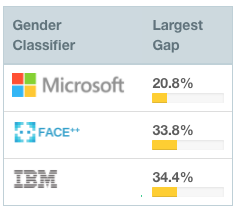
The Gender Shades project evaluates the accuracy of AI powered gender classification products.
This evaluation focuses on gender classification as a motivating example to show the need for increased transparency in the performance of any AI products and services that focused on human subjects. Bias in this context is defined as having practical differences in gender classification error rates between groups.
1270 images were chosen to create a benchmark for this gender classification performance test.
The subjects were selected from 3 African countries and 3 European countries. The subjects were then grouped by gender, skin type, and the intersection of gender and skin type.

 Three companies - IBM, Microsoft, and Face++ - that offer gender classification products were chosen for this evaluation based on geographic location and their use of artificial intelligence for computer vision.
Three companies - IBM, Microsoft, and Face++ - that offer gender classification products were chosen for this evaluation based on geographic location and their use of artificial intelligence for computer vision.
 IBM and Microsoft perform best on lighter males. Face++ performs best on darker males.
IBM and Microsoft perform best on lighter males. Face++ performs best on darker males.

IBM Watson leaders responded within a day after receiving the performance results and are reportedly making changes to the Watson Visual Recognition API. Official Statement.
An internal evaluation of the Azure Face API is reportedly being conducted by Microsoft. Official Statement. Statement to Lead Researcher.
Face++ has yet to respond to the research results which were sent to all companies on Dec 22 ,2017
 At the time of evaluation , none of the companies tested reported how well their computer vision products perform across gender, skin type, ethnicity, age or other attributes.
At the time of evaluation , none of the companies tested reported how well their computer vision products perform across gender, skin type, ethnicity, age or other attributes.
Inclusive product testing and reporting are necessary if the industry is to create systems that work well for all of humanity. However, accuracy is not the only issue. Flawless facial analysis technology can be abused in the hands of authoritarian governments, personal adversaries, and predatory companies. Ongoing oversight and context limitations are needed.
For interested readers, authors Cathy O'Neil and Virginia Eubanks explore the real-world impact of algorithmic bias.

 Automated systems are not inherently neutral. They reflect the priorities, preferences, and prejudices - the coded gaze - of those who have the power to mold artificial intelligence.
Automated systems are not inherently neutral. They reflect the priorities, preferences, and prejudices - the coded gaze - of those who have the power to mold artificial intelligence.
We risk losing the gains made with the civil rights movement and women's movement under the false assumption of machine neutrality. We must demand increased transparency and accountability.
Dive Deeper:
Gender Shades Academic Paper
Test Inclusively:
Request external performance test
Request Pilot Parliaments Benchmark
| Gender Classifier | Overall Accuracy on all Subjects in Pilot Parlaiments Benchmark (2017) |
|---|---|

|
93.7%
|

|
90.0%
|

|
87.9%
|
| Gender Classifier | Female Subjects Accuracy | Male Subjects Accuracy | Error Rate Diff. |
|---|---|---|---|

|
89.3%
|
97.4%
|
8.1%
|

|
78.7%
|
99.3%
|
20.6%
|

|
79.7%
|
94.4%
|
14.7%
|
| Gender Classifier | Darker Subjects Accuracy | Lighter Subjects Accuracy | Error Rate Diff. |
|---|---|---|---|

|
87.1%
|
99.3%
|
12.2%
|

|
83.5%
|
95.3%
|
11.8%
|

|
77.6%
|
96.8%
|
19.2%
|
| Gender Classifier | Darker Male | Darker Female | Lighter Male | Lighter Female | Largest Gap |
|---|---|---|---|---|---|

|
94.0%
|
79.2%
|
100%
|
98.3%
|
20.8%
|

|
99.3%
|
65.5%
|
99.2%
|
94.0%
|
33.8%
|

|
88.0%
|
65.3%
|
99.7%
|
92.9%
|
34.4%
|